
Egg-parasitoids wasp of citrus swallowtail
The final renewal day of this page is June 28, 2005.

The citrus swallowtail(Papilio xuthus Linnaeus) is the butterfly that we see well in a city area. I found several eggs of the citrus swallowtails with the tree of a Japanese orange. I observed that several egg-parasitoids wasps appear from those eggs.
| Figure 14-1 Citrus swallowtail in oviposition Ashiya Hyogo Pref. June 26, 2005 | Figure 14-2 Egg of a citrus swallowtail Ashiya Hyogo Pref. June 26, 2005 | ||
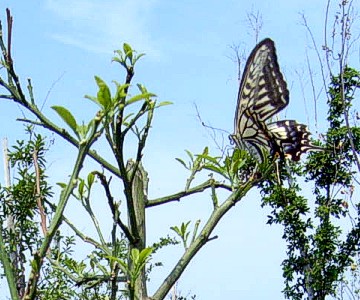 |
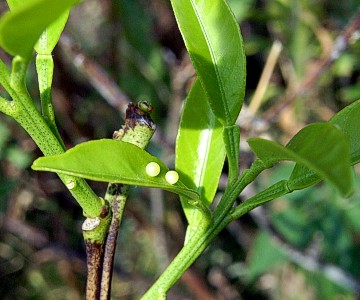 |
||
| Figure 14-31 Several egg-parasitoids wasps are included into this egg. Ashiya Hyogo Pref. June 26, 2005 | Figure 14-4 The form of the egg is almost sphere. However, the bottom of the egg is flat. The diameter of this egg is 1.21 mm. The height of this egg is 1.03 mm. June 26, 2005 | Figure 14-1 Hole that an egg-parasitoids wasp opened The diameter of this hole was 0.23 mm. June 26, 2005 | |
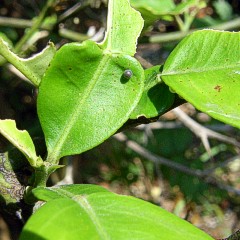 |
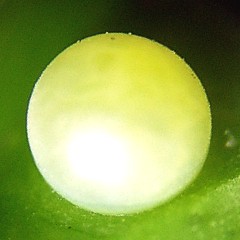 |
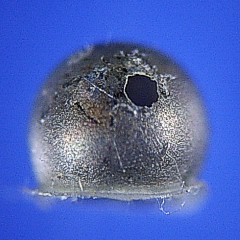 |
|
|
I tried to count the number of the egg-parasitoids wasps that appears out of one egg. Seven females appeared in 15 minutes from this egg. One male appeared after it passes 30 minutes, after all the females went out. June 26, 2005 |
|
| Figure 14-6 A female appeared first. Time is required fairly although the wasp makes a hole to the shell of the egg. The red point that is seen into the egg is the compound eyes of an egg-parasitoids wasp. | Figure 14-7 The 2nd female The 2nd wasp comes out from the hole that the first wasp opened. |
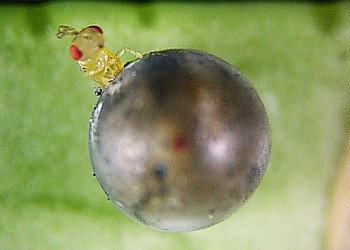 |
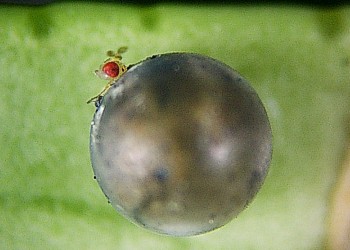 |
| Figure 14-8 The 3rd female The wing of the wasp that appeared from the egg has not grown yet. | Figure 14-9 The 4th female A wasp removes the dust that attached to the leg and body as soon as it goes out from the egg. |
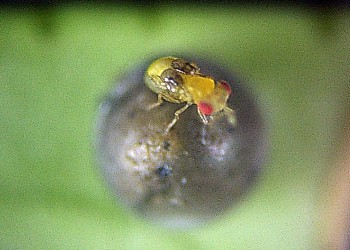 |
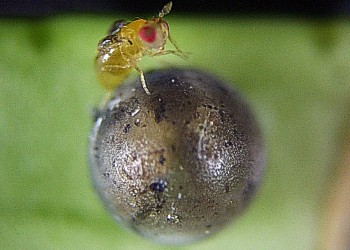 |
| Figure 14-10 The 5th female The wasp on the right side is the 4th female. | Figure 14-11 The 6th female The wasp on the right side is the 4th female. |
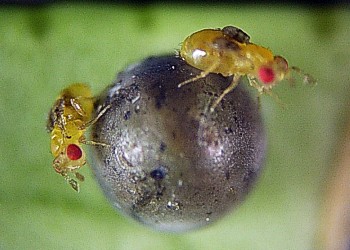 |
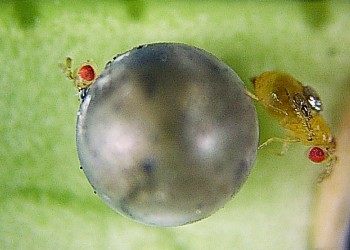 |
| Figure 14-12 The 7th female All the females seem to have gone out. | Figure 14-13 After all the females went out 1 male appeared. |
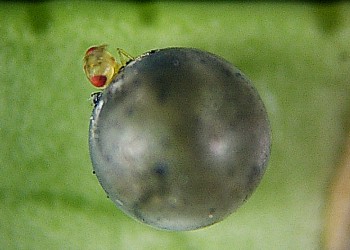 |
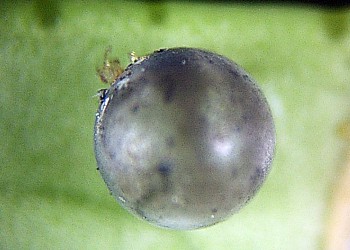 |
|
Twenty females appeared from the egg that observed to No. 2. However, even 1 male did not appear. |
|
| A male appeared previously in the case of this egg. A male is waiting for that a female appears without parting from the egg. Four females and 6 males appeared from this egg. June 27, 2005 | ||
| Figure 14-14 Male This male made a hole to the egg and appeared first. | Figure 14-15 Mating The mating time is several seconds. The wings of these wasps have not grown yet. | Figure 14-16 Male which walks the surroundings of the egg Six males which appeared in this egg were walking the surroundings of the egg. However, wasps transferred it in the place where there are other eggs as time passes. |
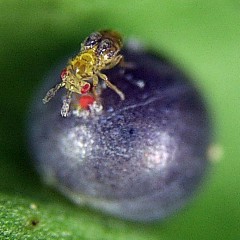 |
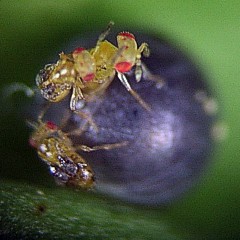 |
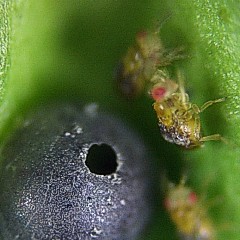 |
| Figure 14-17 Size of the egg-parasitoids wasps The difference by the individual of the size is big. The length of the female is about 0.33〜0.57 mm. The length of the male is about 0.34〜0.46 mm. June 28, 2005 |
Figure 14-18,14-19 Antenna
The form of the antenna of the male is different from the form of the antenna of a female. |
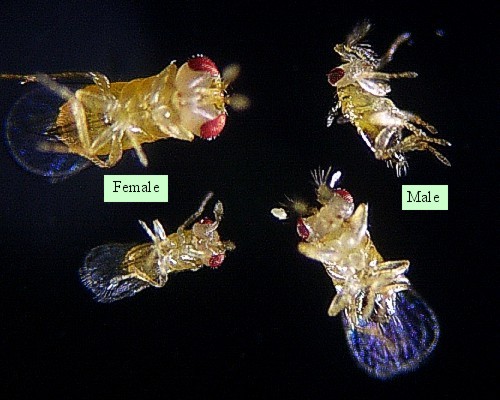 |
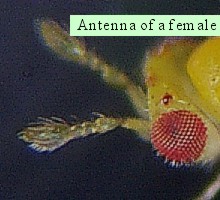 |
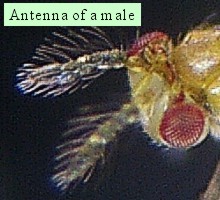 |
|
The wing of this wasp grows after it went out from the egg. A female searches the egg of a citrus swallowtail as soon as the wing grows and lay eggs. June 25-28, 2005 |
|||
| Figure 14-20 Female in immediately after which went out from the egg The wing has not finished yet. | Figure 14-21 Female which the wing finished The body color of the female is yellow. | Figure 14-22 Male which the wing finished The abdomen of the male is dark color. | |
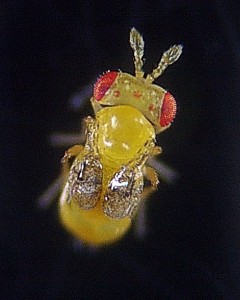 |
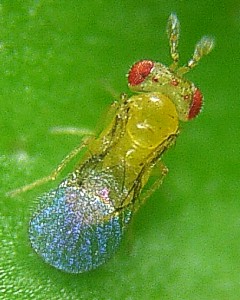 |
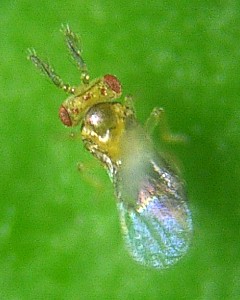 |
|
| Figure 14-23 Oviposition A female moves quickly to search the egg of a citrus swallowtail. The red arrow in the next figure is showing the ovipositor. | Figure 14-24 Male A male is often halting near the egg. As for this male the wing has not grown yet. | ||
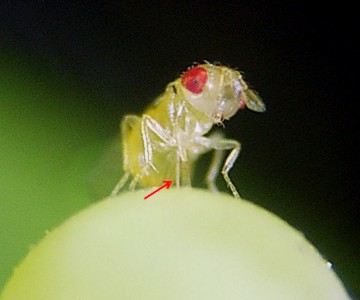 |
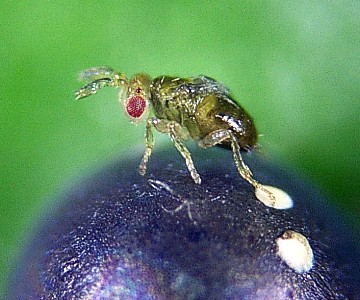 |
||